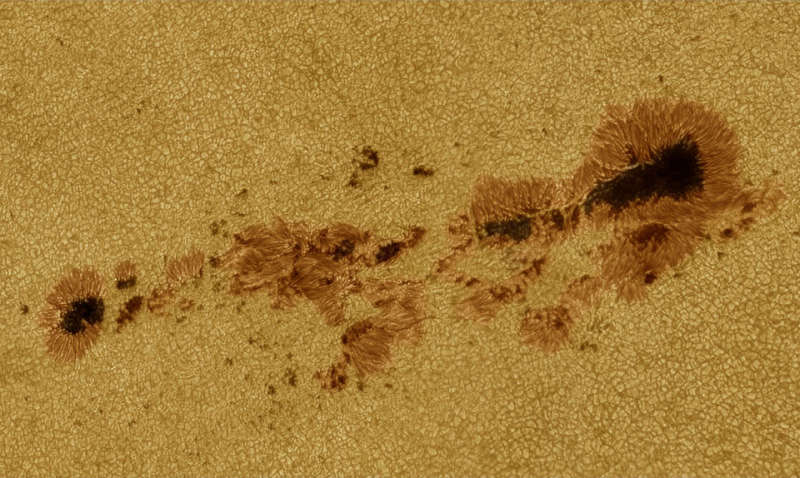Credit & Copyright: Damian Peach
Explanation:
One of the largest sunspot regions in recent years is now crossing the Sun.
This region of convoluted magnetic fields may well produce a
solar flare that releases a cloud of energetic particles
into the Solar System.
Were a very powerful cloud to impact the
Earth's magnetosphere, it could be dangerous to Earth-orbiting astronauts and
satellites.
Conversely, the impact of even a less energetic cloud might create
picturesque aurora.
Pictured above
is the sunspot region as it appeared two days ago.
The rightmost part of this region has been cataloged as
AR 11785, while the left
part as
AR 11787.
The darkest sunspot regions contain
nearly vertical magnetic fields and are called umbras, while the surrounding bronze
regions -- more clearly showing stringy magnetic flux tubes
-- are called penumbras.
Churning solar granules, many about 1000 km across,
compose the yellow background region.
No one knows what this sunspot region will do, but space weather researchers are
monitoring it closely.
Random APOD:
Click here to surf the universe
1999 2000 2001 2002 2003 2004 2005 2006 2007 2008 2009 2010 2011 2012 2013 2014 2015 2016 2017 2018 2019 2020 2021 2022 2023 2024 2025 |
Yanvar' Fevral' Mart Aprel' Mai Iyun' Iyul' Avgust Sentyabr' Oktyabr' Noyabr' Dekabr' |
NASA Web Site Statements, Warnings, and Disclaimers
NASA Official: Jay Norris. Specific rights apply.
A service of: LHEA at NASA / GSFC
& Michigan Tech. U.
|
Publikacii s klyuchevymi slovami:
sunspot - Solnechnye pyatna - Solnechnaya vspyshka - Solnechnaya aktivnost'
Publikacii so slovami: sunspot - Solnechnye pyatna - Solnechnaya vspyshka - Solnechnaya aktivnost' | |
Sm. takzhe:
Vse publikacii na tu zhe temu >> | |
